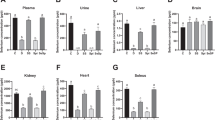Abstract
The aim of the present study is to investigate the accumulation and retention of organic and inorganic selenium in the central nervous system (CNS) of the rat. Selenium accumulation was investigated after oral treatment (3.0 mg Se/L drinking water) or ip injection (1.7 mg Se/kg body wt) of rats exposed to 75-Sel-selenomethionine (SeMeth) or sodium selenite (NaSe). Significant higher concentrations were observed after exposure to organic compared to inorganic selenium after oral as well as ip administration. Highest concentrations in both experiments were observed in cerebellum followed by the nearly identical levels in the cerebral hemisphere and spinal cord independent of the chemical form of selenium or the route of administration. The difference in concentrations observed between the different parts of the CNS investigated in each group were, however, not significant. Retention of selenium in the CNS was investigated after a single ip injection (1.7 mg Se/kg body wt) of 75-Se SeMeth or NaSe. In both groups, we observed an initial fast excretion phase followed by a slower excretion phase resembling a first-order reaction. Organic selenium disappeared much slower from all parts of the central nervous system compared to NaSe after a single injection.
Similar content being viewed by others
References
A. L. Moxon,Saulh. Dak. Agric. Expt. Sta. Bull. 311, 1–91 (1937).
E. M. Ammar, and D. Couri,Neurotoxicology 2, 383–386 (1981).
W. J. Dixon,BMDP Statistical Software. University of California Press, Berkeley, 1983.
G. A. Trapp, and J. Millam,J. Neurochem. 24, 593–595 (1975).
J. R. Prohaska, and H. E. Ganther,J. Neurochem. 27, 1379–1387 (1976).
A. Höch, V. Demmel, H. Schicha, K. Kasparek, and L. E. Feinendegen,Brain 98, 49–64 (1975).
O. Thorlacius-Ussing and F. T. Jensen,Biol. Trace Element Res. 15, 277–287 (1988).
H. Grønbæk and O. Thorlacius-Ussing, inSelenium in Biology and Medicine, A. Wendel, ed., Springer Verlag, Heidelberg, 1989, pp. 130–132.
D. Behne, H. Hilmert, S. Scheid, H. Gessner, and W. Elger,Biochem. Biophys. Acta 966, 12–21 (1988).
O. DeMarchena, M. Guarnieri, and G. McKhann,J. Neurochem. 22, 773–776 (1974).
J. T. Deagen, J. A. Butler, M. A. Beilstein, and P. D. Whanger,J. Nutr. 117, 91–98 (1987).
M. A. Beilstein, and P. D. Whanger,J. Inorg. Biochem. 33, 31–46 (1988).
R. A. Sunde,Annu. Rev. Nutr. 10, 451–474 (1990).
C. Ip,J. Nat. Cancer Inst. 80, 258–262 (1988).
Author information
Authors and Affiliations
Rights and permissions
About this article
Cite this article
Grønbæk, H., Thorlacius-Ussing, O. Selenium in the central nervous system of rats exposed to 75-Sel-selenomethionine and sodium selenite. Biol Trace Elem Res 35, 119–127 (1992). https://doi.org/10.1007/BF02783724
Received:
Accepted:
Issue Date:
DOI: https://doi.org/10.1007/BF02783724




